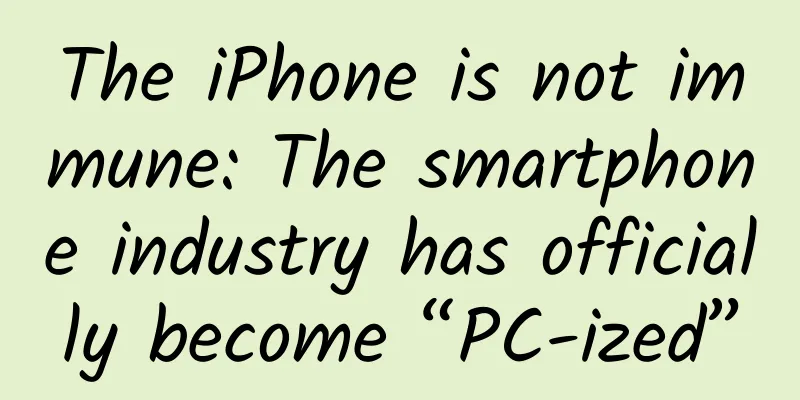The iPhone is not immune: The smartphone industry has officially become “PC-ized”

|
2018 is coming to an end. A lot of things happened this year, and generally speaking, most of them were not good. This is especially true for most players in the mobile phone industry. Gionee went bankrupt; Meitu was sold; Asus announced its withdrawal from most mobile phone markets; Smartisan Technology is on the verge of collapse; second- and third-tier players such as Coolpad, ZTE, Meizu, 360, etc. are basically in a state of drastically shrinking shipments. This winter is particularly cold for many people in the mobile phone industry. 1 On September 12, 2018, Apple released the iPhone Xs series of mobile phones. This is a milestone release of the iPhone. Why do you say that? Because this is the first iteration in the iPhone's 11-year history without any upgrades other than the regular processor. Let's take a look at the upgrade history of the iPhone over the past decade:
Although from the ID point of view, Apple only makes a major upgrade every two years; but even for a minor facelift in the "s" year, Apple always has sufficiently revolutionary software or hardware improvements to promote the evolution of smartphones. The best example is the fingerprint recognition function launched on the iPhone 5s. Let's look back at the iPhone Xs series released this year. Compared with last year's flagship iPhone X, what has been upgraded? I looked and looked. Apart from the normal iteration of the processor, Apple mobile phone finally handed in a blank sheet of paper in its 11th year. No upgrades. To me, this is a landmark event. This marks that the mobile phone industry has officially entered the "PC" era. 2 What is "PCization"? Personal computers have gone through the same journey as mobile phones. In 2017, according to IDC data, global PC shipments reached 259 million units. Guess how many there were 10 years ago? In 2007, global PC shipments were 270.5 million units. PC sales over the past decade have basically been a parabola that has never recovered. After reaching a peak of 367 million in 2012, it has slowly declined and has not stopped falling to this day. The PC was once as glorious as the smartphone. The golden age of PC can basically be traced back to the early 1990s. In 1993, INTEL launched the famous Pentium processor, and began its journey to become the leader in the processor field. A year later, in 1994, Windows 3.2 was released, which supported Chinese for the first time. Most of us started to learn about computers in this year. The next decade or so was the golden age of PC. The "Wintel" alliance composed of Microsoft and INTEL holds high the banner of Moore's Law, leading PC manufacturers to launch exciting new products almost every year. From the DIY era, various computer components have been surging, leading the way, to PC manufacturers gradually occupying the commercial market, and then to notebook computers sweeping the world. Faster, stronger, and thinner products are constantly iterating and growing at a high speed. Until 2012. PC sales experienced their first decline. Just like smartphones: by 2012, the competition in the PC industry had basically evolved in terms of product form. The input of keyboard + mouse, the output system of display + speaker, and the graphical interaction of Windows have been stable for many years; the clamshell notebook has also formed a stable interaction, and the thickness, weight and battery life have basically reached a very high level. You should know that the MacBook Air released in 2008 is only 4mm at its thinnest point and weighs only 1.36KG. Even today, 10 years later, this data is still portable enough. Does it look like today’s smartphones? 3 As smartphones have reached 2018, I believe that their overall interaction and product form have basically been upgraded. The front has an end-to-end full-screen design (Edge to edge display); facial recognition is the main unlocking method; and the module consists of 1-3 cameras on the front and back. Faster processors, better camera effects, stronger battery life, charging performance and thinner design - these will of course continue to iterate, but the phone should look like what you see today, and there will be no essential changes in form and interaction. Some people will say that you are too pessimistic. Haven’t you seen that in 2018, Vivo released the Nex series, which used a pop-up camera to achieve a truly bangs-free full-screen? Oppo, Honor, Lenovo, and Xiaomi have all launched sliding full-screen products? There is also ZTE’s folding screen, Vivo Nex2’s double-sided screen... How many mobile phone manufacturers have continued to break through the restrictions set by Apple and pursue a more comprehensive full-screen? How can we say that the form has been basically determined?
First of all, I don’t think these excessive pursuits of full-screen displays are the right product trends. Secondly, whether it is the notch screen, the water drop screen, or even the latest punch hole screen, it is still a gradual optimization based on the "edge to edge display" design language, not an innovation in form interaction. Everything is within the existing logic. As for double-sided screens and folding screens, I can only say that the definitions of these products are extremely wrong. 4 In fact, the personal computer industry has gone through the same process. Let's go back to 2012. PC manufacturers certainly did not sit idly by during the recession that year. In October 2013, INTEL teamed up with many PC manufacturers to launch the "Ultrabook". Ultrabooks attempted to innovate in product form, launching two categories, "detachable" and "convertible", defining the category as "transformable notebook" and proposing the slogan of "PC tablet two-in-one". All of a sudden, various PC manufacturers came up with various tricks to show off their capabilities: in addition to the common two-in-one laptops that can be detached into tablets, Lenovo launched the "Yoga" series of products that can be flipped 360 degrees; Asus launched the dual-screen "Tai Chi" notebook; all of these notebooks support screen touch and are equipped with the latest Windows 8 system, hoping to completely change the way people use traditional "Clamshell" notebooks. However, the reality did not match expectations. The emergence of ultrabooks did not save the PC from its decline. Users were completely unwilling to pay for the new form factor that manufacturers had forcefully promoted. When people bought ultrabooks home, they actually still used them as traditional notebooks, and basically did not use the so-called new form factor and interaction. Everything was back to square one. Like PCs, double-sided screens, folding screens, sliding full-screen screens, and various "innovations" and "iterations" in product forms that will appear in the next few years, in my opinion, will not bring about fundamental changes to the product form of existing smartphones. Another problem caused by the solidification of application scenarios is the excess of performance. Although Intel has been working hard to maintain the iteration speed of Moore's Law in the past decade (it has slowed down to 3 years in recent years), this performance improvement has not brought about a significant improvement in experience. The iteration cycle of PCs has been extended again and again: even a laptop from 5 years ago can still be used smoothly today. Users have almost no demand for upgrading. This trend has also gradually emerged for smartphones: in 2010, the most aggressive mobile phone users would replace their phones almost every six months; today, the iteration cycle for most people's phones has exceeded two years. Although the performance of today's smartphone processors is far from being excessive, the day of performance saturation should not be far away. 5 The final evidence of the “PCization” of mobile phones is brand concentration. In 2017, the world's top five mobile phone brands accounted for more than 60% of the market share. If this data seems healthy, let's take a look at the more competitive Chinese market: In 2017, the top five smartphone brands in the Chinese market accounted for 75.7% of the market share, while "other" brands accounted for only 24.3%, a year-on-year decrease of 31%. Let's look at the PC market:
How similar. Smartphones and personal computers, which once experienced a golden age with dozens of brands competing for the top spot, are now left with only the top players left. To this day, if mobile phone practitioners other than the four major Chinese mobile phone companies "Huami, OV" have not yet realized today's situation, they are probably a bit slow. The "PCization" era of mobile phones has arrived. |
<<: 12 Mobile App Development Trends to Watch in 2019
>>: WeChat 7.0 Android version preview: Beware that your short videos may be viewed by strangers
Recommend
How to solve food safety issues at sea?
Listen to the interpretation of "Science Int...
A complete App operation and promotion plan!
1. Concept of App operation and promotion Quoting...
Do you know how important this inconspicuous little moss is?
Disclaimer: In accordance with general ecological...
Teach you step by step to create a Word to HTML program using PHP
[Original article from 51CTO.com] In some special...
WordPress personal website building tutorial, WordPress website building tutorial complete set of twelve sections [Directory]
This complete set of WordPress website building t...
Lack of this vitamin may lead to Alzheimer's disease...
Reviewer of this article: Chen Haixu, Deputy Dire...
Is this the real "water ball" in the universe? With more than 10% of water, it can "kill" the earth in seconds!
Author: Huang Xianghong Duan Yuechu In the depths...
From conception to breastfeeding, science is quietly healing the pain that mothers endure for us
Mothers give us life. It is not until we grow up,...
Property management should be free in the Internet age
When free becomes a "business card" in ...
If you suffer from kidney stones, you must pay attention to these 5 points, otherwise be careful that the stones will become bigger!
Did you know? Today is #WorldKidneyDay#. The Inte...
During the epidemic, this native rural commercial bank did these things
[51CTO.com original article] Spring has not yet a...
The Xiaomi Mi 5S is not the right medicine for the right condition.
In recent times, Xiaomi has been plagued by negat...
Analysis of mobile advertising in the skin care and beauty industry in Q1 2019
The first quarter of 2019 has passed. So what are...
Is social phobia inherited? See if your parents have these traits
Audit expert: Yin Tielun Deputy Chief Physician, ...
China's Sky Eye is amazing! The "identity card" of repeated fast radio bursts has been found
◎ Science and Technology Daily reporter Lu Chengk...









